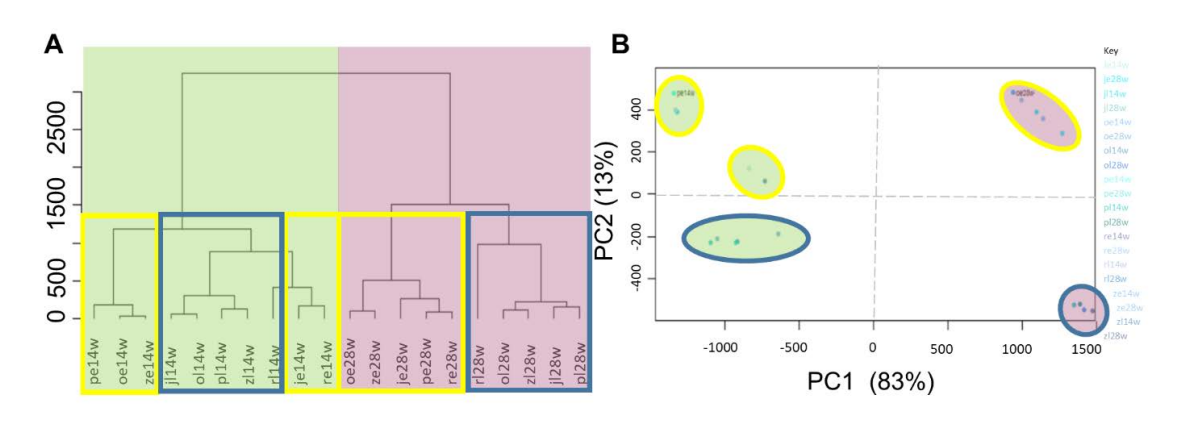Monitoring a metabolic profile of wheat by using FTIR spectroscopy and chemometric methods — concept studies
DOI:
https://doi.org/10.55225/sti.493Keywords:
metabolic fingerprint, FTIR, HCA, PCA, stress factorsAbstract
Changes in plants under the influence of a variety of chemical and physical factors are reflected in metabolomic changes. To date, there are very few methods that would allow studying metabolic changes occurring in single cells. Spectroscopic methods especially combined with the chemometrics methods are a very good tool to investigate such changes in metabolomics. Tracking changes in plants is of particular importance in industry, especially when studying how the use of fertilizers affects plants. In this paper, we present preliminary research as
a concept of proof to examine whether the use of FTIR (Fourier transform infrared spectroscopy) helps to monitor the changes in the metabolomic profile of the plants. For preliminary research, four species of cereals and cuckooflower were used. In this step, it was possible to verify the differences in metabolites that are produced by plants belonging to different families. Then one species of grain was selected and subjected to eleven different physical and chemical factors. Next, the research was expanded to determine the optimal concentration of hydrogen peroxide. FTIR spectra of leaves and extracts of the plants were obtained for all experimental groups and then analyzed with the use of chemometric methods: HCA (hierarchical component analysis) and PCA (Principal component analysis). Those methods were used to help in the interpretation of metabolic changes resulting in the plant in response to external factors.
Downloads
References
Gidman E, Goodacre R, Emmett B, Smith AR, Gwynn-Jones D. Investigating plant-plant interference by metabolic fingerprinting. Phytochemistry. 2003;63(6):705–710. https://doi.org/10.1016/S0031-9422(03)00288-7. DOI: https://doi.org/10.1016/S0031-9422(03)00288-7 Google Scholar
Gumiński S. Ogólna fizjologia roślin. Ed. 2. Warszawa: Państwowe Wydawnictwo Naukowe; 1983. Google Scholar
Fukusaki E, Kobayashi A. Plant metabolomics: Potential for practical operation. Journal of Bioscience and Bioengineering. 2005;100(4):347–354. https://dx.doi.org/10.1263/jbb.100.347. DOI: https://doi.org/10.1263/jbb.100.347 Google Scholar
Shulaev V, Cortes D, Miller G, Mittler R. Metabolomics for plant stress response. Physiologia Plantarum. 2008;132(2):199–208. https://doi.org/10.1111/j.1399-3054.2007.01025.x. DOI: https://doi.org/10.1111/j.1399-3054.2007.01025.x Google Scholar
Corlett RT. Plant diversity in a changing world: Status, trends, and conservation needs. Plant Diversity. 2016;38(1):10–16. https://doi.org/10.1016/j.pld.2016.01.001. DOI: https://doi.org/10.1016/j.pld.2016.01.001 Google Scholar
Obata T. Metabolons in plant primary and secondary metabolism. Phytochemistry Reviews. 2019;18(6):1483–1507. https://doi.org/10.1007/s11101-019-09619-x. DOI: https://doi.org/10.1007/s11101-019-09619-x Google Scholar
Hounsome N, Hounsome B, Tomos D, Edwards-Jones G. Plant metabolites and nutritional quality of vegetables. Journal of Food Science. 2008;73(4):48–65. https://doi.org/10.1111/j.1750-3841.2008.00716.x. DOI: https://doi.org/10.1111/j.1750-3841.2008.00716.x Google Scholar
Czerwiński W. Fizjologia roślin. Ed. 3. Warszawa: Państwowe Wydawnictwo Naukowe; 1978. Google Scholar
Jia X, Wang W, Chen Z, He Y, Liu J. Concentrations of secondary metabolites in tissues and root exudates of wheat seedlings changed under elevated atmospheric CO₂ and cadmium-contaminated soils. Environmental and Experimental Botany. 2014;107:134–143. http://dx.doi.org/10.1016/j.envexpbot.2014.06.005. DOI: https://doi.org/10.1016/j.envexpbot.2014.06.005 Google Scholar
Dunn WB, Ellis DI. Metabolomics: Current analytical platforms and methodologies. TrAC Trends in Analytical Chemistry. 2005;24(4):285–294. https://doi.org/10.1016/j.trac.2004.11.02. DOI: https://doi.org/10.1016/j.trac.2004.11.021 Google Scholar
Ellis DI, Harrigan GG, Goodacre R. Metabolic fingerprinting with Fourier transform infrared spectroscopy. In: Harrigan GG, Goodacre R, editors. Metabolic Profiling: Its Role in Biomarker Discovery and Gene Function Analysis. Boston, MA: Springer; 2003; p. 111–124. https://doi.org/10.1007/978-1-4615-0333-0_7. DOI: https://doi.org/10.1007/978-1-4615-0333-0_7 Google Scholar
O’Gorman A. Metabolic Profiling and Fingerprinting for the Detection and Discrimination of Mechanical Damage in Mushrooms (Agaricus bisporus ) during Storage. [doctoral thesis]. Dublin: Technological University Dublin; 2010. https://doi.org/10.21427/D7DK5P. Google Scholar
Zuppinger-Dingley D, Flynn DFB, Brandl H, Schmid B. Selection in monoculture vs. mixture alters plant metabolic fingerprints. Journal of Plant Ecology. 2014;8(5):549–557. https://doi.org/10.1093/jpe/rtu043. DOI: https://doi.org/10.1093/jpe/rtu043 Google Scholar
Johnson HE, Broadhurst D, Goodacre R, Smith AR. Metabolic fingerprinting of salt-stressed tomatoes. Phytochemistry. 2003;62(6):919–928. https://doi.org/10.1016/S0031-9422(02)00722-7. DOI: https://doi.org/10.1016/S0031-9422(02)00722-7 Google Scholar
Yunitasari N, Swasono RT, Pranowo HD, Raharjo TJ. Phytochemical screening and metabolomic approach based on Fourier transform infrared (FTIR): Identification of α-amylase inhibitor metabolites in Vernonia amygdalina leaves. Journal of Saudi Chemical Society. 2022;26(6):101540. https://doi.org/10.1016/j.jscs.2022.101540. DOI: https://doi.org/10.1016/j.jscs.2022.101540 Google Scholar
Sahoo MR, Umashankara MS. FTIR based metabolomics profiling and fingerprinting of some medicinal plants: An attempt to develop an approach for quality control and standardization of herbal materials. Pharmacognosy Research. 2023;15(1):163–167. https://doi.org/10.5530/097484900288. DOI: https://doi.org/10.5530/097484900288 Google Scholar
Wijaya H, Yuliana ND, Wijaya CH, Nasrullah N. Classification of Trigona spp bee propolis from four regions in Indonesia using FTIR metabolomics approach. In: 13th ASEAN Food Conference, 9–11 September 2013, Singapore “Meeting Future Food Demands: Security and Sustainability”. Singapore; 2013. Google Scholar
Khalid Hussain, Zhari Ismail, Amirin Sadikun PI. Evaluation of metabolic changes in fruit of piper sarmentosum in various seasons by metabolomics using Fourier Transform Infrared (FTIR) spectroscopy. International Journal of Pharmaceutical and Clinical Research. 2009;1(2):68–71. Available from: https://www.myresearchjournals.com/index.php/IJPCR/article/view/5651. Google Scholar
Olko A, Kujawska M. Podwójna rola H₂O₂ w odpowiedzi roślin na działanie warunków stresowych. Kosmos. 2011;60(1–2):161–71. Google Scholar
Hanson BA. ChemoSpec: Exploratory Chemometrics for Spectroscopy. 2016. [Internet]. Available from: github.com/bryanhanson/ChemoSpec. Google Scholar
Stuart BH. Infrared Spectroscopy: Fundamentals and Applications. Chichester: Wiley; 2004. http://doi.wiley.com/10.1002/0470011149. DOI: https://doi.org/10.1002/0470011149 Google Scholar
Geethu MG, Suchithra PS, Kavitha CH, Aswathy JM, Babu D, Murugan K. Fourier-transform infrared spectroscopy analysis of different solvent extracts of water hyacinth (Eichhornia crassipes mart solms.) an allelopathic approach. World Journal of Pharmacy and Pharmaceutical Sciences. 2014;3(6):1256–1266. Google Scholar
Schmitt J, Flemming H-C. FTIR-spectroscopy in microbial and material analysis. International Biodeterioration and Biodegradation. 1998;41(1):1–11. https://doi.org/10.1016/S0964-8305(98)80002-4. DOI: https://doi.org/10.1016/S0964-8305(98)80002-4 Google Scholar
Preston LJ, Izawa MRM, Banerjee NR. Infrared spectroscopic characterization of organic matter associated with microbial bioalteration textures in basaltic glass. Astrobiology. 2011;11(7):585–599. http://doi.org/10.1089/ast.2010.0604. DOI: https://doi.org/10.1089/ast.2010.0604 Google Scholar
Baciu A, Ranga F, Fetea F, Zavoi S, Socaciu C. Fingerprinting Food supplements and their botanical ingredients by coupled UV/Vis/FTIR spectrometry. Bulletin UASVM Food Science and Technology. 2013;70(1):8–15. https://doi.org/10.15835/buasvmcn-fst:9246. DOI: https://doi.org/10.15835/buasvmcn-fst:9246 Google Scholar
Baranska M, Schulz H. Chapter 4: Determination of alkaloids through infrared and Raman spectroscopy. In: Cordell GA, editor. Alkaloids: Chemistry and Biology. Volume 67. Amsterdam–Boston: Elsevier/Academic Press; 2009. p. 217–255. DOI: https://doi.org/10.1016/S1099-4831(09)06704-2 Google Scholar
Wojtkowiak B, Chabanel M. Spektroskopia molekularna. Warszawa: Państwowe Wydawnictwo Naukowe; 1984. Google Scholar

Downloads
Published
How to Cite
Issue
Section
License
Copyright (c) 2023 Aleksandra Borek-Dorosz, Rafał Kurczab

This work is licensed under a Creative Commons Attribution-ShareAlike 4.0 International License.



